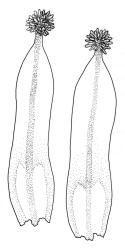Plants bright yellow-green below, bright green above when fresh, forming small, dense cushions on trunks. Stems c. (3–)7–10 mm; rhizoids inconspicuous. Leaves strongly curved inwardly when dry, erect-spreading when moist, monomorphic, scarcely differentiated into a base and upper lamina ("limb"), oblong or panduriform, broadly obtuse or rounded at apex, with a strong and stout mucro bearing a spherical cluster of gemmae, to 2.7 × c. 0.5–0.65 mm (under cover slip); cancellinae extending c. ¼ the leaf length, forming a rounded junction distally with chlorophyllose cells, with hyaline cells rectangular and mostly c. 60–75 × c. 30 µm; leaf margins lacking both marginal and intra-marginal borders, entire throughout, bistratose above; upper laminal cells isodiametric to shortly rounded-rectangular, firm-walled, dark green, mostly c. 6–8 µm in greater diam., appearing mammillose in surface view, in cross-section strongly bulging on adaxial surface. Costa stout, shortly excurrent, protruding strongly abaxially and bright yellow in fresh material, in cross-section with median guide cells and two stereid bands, scarcely tapered, swollen at apex, smooth adaxially, strongly mammillose above abaxially, bearing spherical apical clusters of gemmae surrounding the costal apex. Gemmae narrowly fusiform, transversely septate, 6–9-celled and c. 150–200 µm long.
Sexuality unknown. Sporophytes not present in N.Z. material.
Whittier 1976, fig. 31, h–k; Eddy 1990, fig. 249; Reese 1994, fig. 154.
Peter de Lange (pers. comm., 7 Oct. 2008), who has made all the N.Z. gatherings, considers this species to be "a distinctive honey-brown or bright yellow colour" when dry; in Fiji the fresh plants are usually dark green when dry and only the costae and/or the lower portions of the shoots are yellow-tinged.
The distinctive cancellinae, which are obvious even with a hand-lens, and the apical cluster of gemmae on most leaves will place this species as a member of the family Calymperaceae. Compared with its congener C. tahitense, this is a much smaller plant with gemmae surrounding the terminus of the costa. The leaves of C. tenerum lack teniolae and their cancellinae lack the interdigitated files of green and hyaline cells that characterise C. tahitense.
Calymperes tenerum is likewise very distinct from our one species of Syrrhopodon by its lack of both a leaf border and basal marginal spines, as well as the nature of its terminal gemmae clusters. Calymperes tenerum could be taken for a small epiphytic species of Syntrichia, such as S. papillosa or S. laevipila. The widespread S. papillosa has irregularly shaped gemmae scattered on the abaxial costal surface and a long-excurrent costa. Syntrichia laevipila likewise has a long-excurrent costa, but its gemmae occur in a cluster at the apex of the stem. Neither of these two species has cancellinae in the leaf base.
K (Fishing Rock Road, Ring Buster Bluff); NI: N Auckland (Te Paki); Ch (Southern Tablelands, Ocean Mail Scenic Reserve, and Pitt I.).
Pantropical. Widespread in the Pacific, south-east Asia, west to India, and in northern Australia; reported from several scattered western hemisphere localities by Reese (1994).
One Chathams collection (P.J. de Lange CH713, AK 297863) was made from "sheltered, shady conditions" on the bark near the base of Coprosma chathamica on a ridge at the Sweetwater Covenant on the Southern Tablelands, at 247 m elev., a second from rotting Corynocarpus near sea level at Ocean Mail (P.J. de Lange & P.B. Heenan CH2282, CHR 604759) and a third (P.J. de Lange & P.B. Heenan CH1443, CHR 593694) from a nīkau palm (Rhopalostylis sapida) trunk at Waipāua, Pitt I., at 40 m elevation. One Te Paki collection grew on rotten bark of pōhutukawa (Metrosideros excelsa) in association with Acrolejeunea securifolia and Macromitrium brevicaule; a second Te Paki collection grew between pōhutukawa roots overlying a serpentine boulder in an ephemeral stream bed.
One of the Kermadec Is collections (Ring Buster Bluff) is unusual by its general lack of terminal clusters of gemmae. However, in a few stems of this collection the terminal "generative areas" at the end of the costae can be seen and the collection is in other respects representative of C. tenerum.
Fife & de Lange (2009) speculated that shearwater-mediated transport of gemmae may have led to the establishment of C. tenerum on the Chatham Is.











